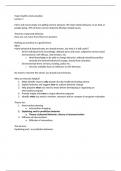Topic Health communication
Lecture 1
More and more people are getting chronic diseases: life-style related diseases. If we look at
people dying, 70% of them can be related to lifestyle related issues.
Theories of planned behavior.
How you can move from theory to practice.
Nothing as practical as a good theory.
Why?
Many behavioral determinants are already known, but why is it still useful?
- At the individual level, knowledge, attitude (pros and cons), subjective norms (social
environment), self-efficacy, intervention, etc.
o Need knowledge to be able to change behavior, attitude should be positive
towards the desired behavioral change, should form intention.
- Environmental level: services, funding, policy etc.
o Services available have an influence on the behavior.
No need to reinvent the wheel, we already have theories.
Why are theories helpful?
1. Helps identify reasons why people do take health-promoting actions
2. Explain behavior and suggest how to achieve behavior change
3. Help pinpoint what you need to know before developing or organizing an
intervention program
4. Provide insight into how to shape effective programs
5. Identify what you need to monitor, measure and/or compare in program evaluation
Theory for:
1. Intervention planning
a. Intervention mapping
2. Explaining and/or prediction behavior
a. Theory of planned behavior, theory of reasoned action
3. Diffusion of interventions
a. Diffusion of innovations
This lecture:
Explaining and / or prediction behavior.
,Intention is the biggest predictor for behavior. Once you have formed the intentions, you will
be more likely to act, which in turn influences the attitude. Attitude = general feeling
towards a behavior.
Also subjective norm (normative beliefs: what you think other people will think of this
behavior),
and motivation to comply: Also the people that want you to behave a certain way. For
example, your parents want you to stop doing drugs or your friends want you to stop doing
drugs.
, attitude towards behavior, behavioral beliefs, evaluation of behavioral outcomes,
normative beliefs, motivation to comply.
- Behavior is determined by behavioral intention, which is in turn determined by the
attitude towards the behavior
- Subjective norms: Do you feel like your social environment approves or disapproves
of the behavior
- Normative beliefs: what you think other people will think of this
- Motivation to comply
More likely to comply to your friends than to your parents.
,Later added in the theory of planned behavior:
Control belief + perceived power perceived behavioral control.
Going to the gym more often costs more money, but I have enough money so that won’t
influence your perceived behavioral control.
- Control beliefs:
Potential difficult situations that can arise.
- Perceived power
Perception of ability to overcome these situations.
, The I-change model
More complex, integrates multiple theories. Self efficacy. (Smit et al. 2012)
Also Trans-theoretical model, social cognitive theory, relieve model.
Someone’s intention is the biggest predictor: but intention has different stages.
Most important predictor is behavioral intention:
1. Preparation stage
Planning to change in the coming month.
2. Contemplating stage
Planning to change behavior within next 6 moths.
3. Pre-contemplating stage
(Not anytime soon) Not planning on changing your behavior
Motivational factors:
1. attitude (pro’s and con’s, and rational and emotional),
2. social influences (social norms, social modelling (what do others do) and social
pressure,
3. self-efficacy (routine, situational, social & stress).
awareness factors
1. knowledge,
You are aware of the problem:
You know you can get cancer from smoking
2. cues to action
Someone dying of cancer in your environment




